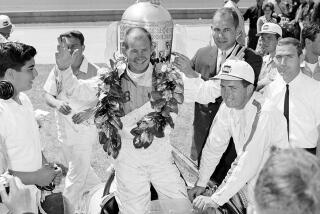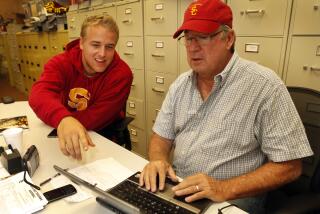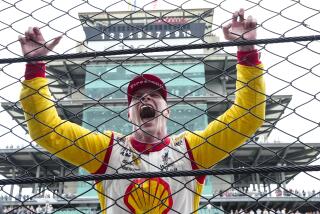A Tamer of Deadly Shrews
- Share via
When you look at a race car, what do you see? A collection of nuts and bolts, rubber, a chassis plastered with decals, sparkling chrome, the automotive equivalent of a crouched leopard, sleek and dangerous?
Rick Mears looks at it and sees a trollop, a perverse, demanding, temperamental mistress, the automotive equivalent of an opera diva. If it were human, she’d throw things at you. She’s given to tantrums, pouting. A shrew. Katharine Hepburn with wheels.
Rick Mears is to racing what Wade Boggs or Tony Gwynn is to batting. You have him to beat. Beat him and take it all.
He is, without question, the No. 1 Indy car chauffeur in the world. Emerson Fittipaldi is having a year guys in garages in Torrance only dream about. But he has to do it about six more years to range alongside Rick Mears.
Mears has won three Indianapolis 500s. Only A. J. Foyt and Al Unser (pere) have won four, and Foyt is about to become 55 and the elder Unser is 50.
Rick Mears has not only won three 500s in 10 years, he has been on the pole five times. He has started from the front row nine times in 12 years. He set the speed record in 1982, ‘84, ‘86, ’88 and ’89. He set a lap record of 224.254 m.p.h. last May. He owns Indy. Catch him if you can.
But the thing about Rick Mears is, he’s not only a driver, he’s part of the car.
The old romantic days of white-scarf-leather-helmet-and-goggles driving, the wheel-to-wheel, smoking-engine surges into the corners is as long gone as the hand crank. You have to be a computer today, Rick Mears notes, but not just another data bank. You still have to romance that car, wheedle her to be nice, do everything but bring her flowers and perfume. Promise her anything. Hope she behaves.
The cars today are so high-strung and skittish, it’s like a date with a Bette Davis character. The least little thing can set her off. You tend to find yourself holding your breath, listening for the next outbreak.
Take last spring’s Indy race. Rick Mears was on top of the world. He had won the ’88 Indy from the pole, becoming the race’s fourth three-time winner. He had set the track record, 220.453, the qualifying record, 219.198, and he was on Roger Penske’s team, which is like being on the Lombardi Packers or the Ruth Yankees.
He was on the pole again in ‘89, the first 220-plus qualifier.
The race was just a formality. A 500-mile parade lap.
They forgot to consult Her Ladyship, the car. The strumpet. She wasn’t about to be taken for granted.
They no sooner dropped the green flag than she showed her bitchiness. First, Fittipaldi flashed past her, then Mario Andretti. And they hadn’t even reached Turn 1.
She was rubbing Rick Mears’ face in it. Pole-sitters do not like to relinquish first place that quickly nor that decisively. They’d almost rather hit a wall.
The least the car should have done was let him do it gracefully, 10 laps into the race. She would have none of it.
“It was a pop-off valve,” recalls Mears, ruefully. “We were only getting 42 inches of boost (from the turbocharger). We were supposed to be getting 45 to 46. We could never make any horsepower. We had to struggle to get 217 (m.p.h.) and were hard-pressed to stay up with the field.”
A race driver knows rejection when he sees it--and Mears tried everything. He romanced the lady but on this day she was a tramp. He contacted the pit. He recommended changes in the angle of the wings, he discussed the steering, the stagger. She kept hanging up on him.
“This is why you have to be sensitive to the car’s needs nowadays,” he says.
You have to recognize every nuance of her behavior. If you don’t, you might as well park and walk home.
An uncooperative car can ruin more than your evening, as Rick found out at Sanair in Montreal in August 1984, when his car slithered him under a guard rail and almost severed his toes, to say nothing of the rest of him. His feet looked like two pounds of ground round for months but, with special shoes, he went back to racing.
Mears would be a four-time Indy winner today, but for an injudicious pit stop in the final laps of the 1982 race. Eleven seconds behind Gordon Johncock with 12 laps to go, he caught up with Johncock’s slower car on the white-flag lap but his heavier fuel load kept him from passing and enabled Johncock to stay just a hair’s breadth in front of him in the closest finish--0.16 of a second--in Indy history.
Two weeks ago, he handed Fittipaldi the CART PPG national driving title when he tried to race out of the pits with part of the fueling equipment still attached. Black-flagged in, he lost the race--by five seconds. At Portland this year, she ran out of gas on him. Fittipaldi went by him to win.
Mears takes his Pennzoil Penske sophisticated lady to a doubleheader at Laguna Seca Raceway next weekend, a Marlboro Challenge race-off and a Champion 300-kilometer PPG event.
But what he really wants to do is get on good terms with his escort for next year. He’ll have to be very attentive to her needs and do everything short of singing under her balcony. Otherwise, she won’t, so to speak, return his calls again. Or, maybe, when she gets him out in public, she’ll jilt him at the first turn again.
It’s getting so he can’t take her anywhere.
More to Read
Go beyond the scoreboard
Get the latest on L.A.'s teams in the daily Sports Report newsletter.
You may occasionally receive promotional content from the Los Angeles Times.










